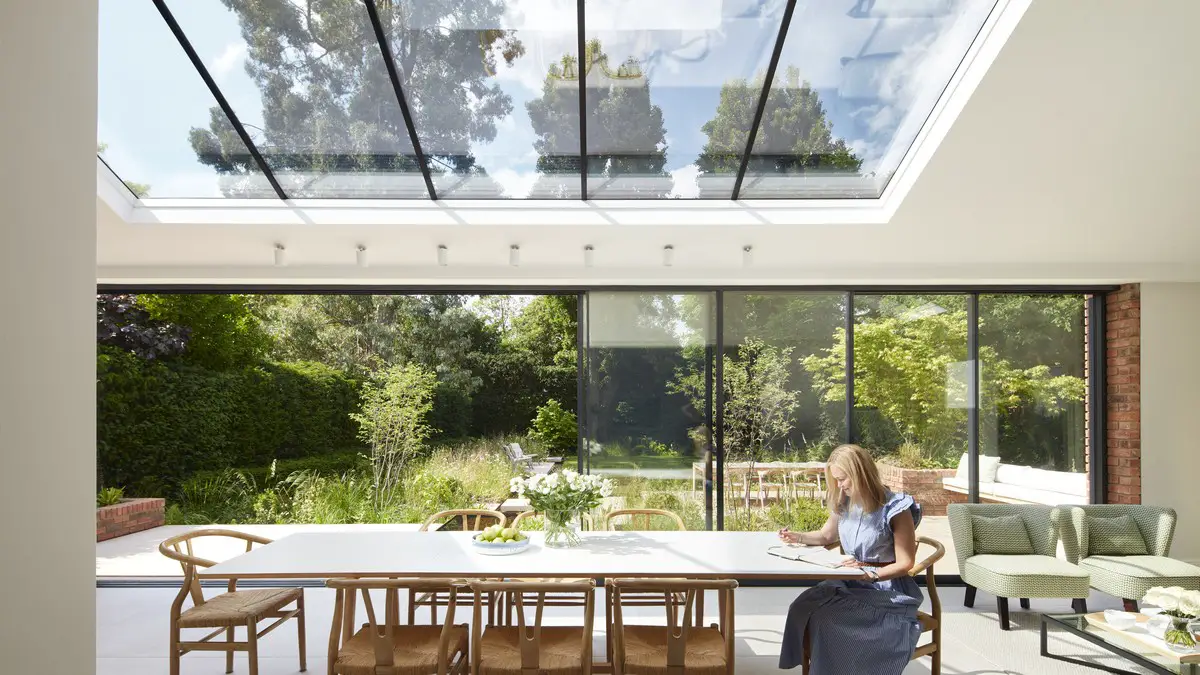Specifying large conservation rooflights, Home modular skylights, Building roof windows
Specifying Large Conservation Rooflights
3 July 2024
The Elephant in the Roof
Paul Trace from Stella Rooflight discusses the practicalities involved in specifying large conservation rooflights
We often see grand plans with expansive areas of roof glazing, as architects continue to seek innovative ways in which to exploit natural daylight. As much as bespoke rooflights can certainly help bring these designs to life, there are some important factors that need to be considered when the glazing is turned from drawing to reality.
Specifying Large Conservation Rooflights Trend
In recent years we have noticed a trend towards larger rooflights, with sizes regularly exceeding 2500mm in width, height or both. While a bespoke rooflight manufacturer can certainly accommodate these, one has to appreciate the practicalities of weight, transportation and cost.
It stands to reason that the larger the rooflight, the thicker the glass will need to be, therefore as rooflight sizes get bigger their weight can increase exponentially. In context, a double glazed unit made using 4mm thick glass, weighs 20kgs per square metre and those using 6mm are 30kgs per square metre. Triple glazed units are 30kgs and 45kgs respectively. Add the metal frames and liners into the equation and you can start to see how even a modest sized conservation rooflight can weigh something akin to a small elephant! Indeed it’s not uncommon for rooflights to weigh in excess of 200kg.
The reality is that when you scale things up even the simplest plans can start to become complex – a truth that should be all too familiar to architects. It is important to consider at an early planning stage how the rooflight is going to be lifted from the ground to roof level and what the weight implications might be for the structure. It is possible to weld eyelets to the rooflight frame to aid the lifting process and we would suggest doing this on frames which weigh in excess of 100kg, which is the point where we expect a crane might be required. However, does the site have suitable access for any specialist lifting equipment, and has this additional cost been budgeted for?
The weight of an opening rooflight will also determine whether it is manually operated or requires electric actuation. We would suggest that the largest manually operated rooflight be around 1000mm wide or 1400mm high. Anything over this size will generally require electric actuation to lift the weight and in the case of wider casements, to provide a tight seal. Manual operating casements are less expensive than electric so there is a cost element that also needs to be considered when specifying larger opening rooflights. There is no maximum size in terms of what is possible to manufacture, although it is worth keeping in mind that a single piece of glass with an area over 5m2 becomes significantly more expensive.
Fortunately there are alternatives to using large expensive single panes of glazing, such as introducing glazing bars to reduce the unit sizes, linking frames, and having more than one casement. This not only makes the rooflights easier to transport, lift and install, but can also reduce the price.
If a large, single rooflight is the only option for your project then you must also make sure that it is safe to install. While rooflight manufacturers will be able to provide advice on a suitable specification for the job in terms of materials, glazing thickness, functionality and installation, it is ultimately the responsibility of a structural engineer to ensure that the product being specified is fit (and safe) for the building that it is fitted into.
To avoid any ambiguity it is essential that the architect, structural engineer and rooflight manufacturer discuss large rooflight installations, likely weights, load bearings, site access, and lifting capacity at an early stage to avoid any problems down the line. It is not advisable to leave this for the builder to deal with at the last minute.
Another area for consideration should be the safety of large areas of glazing situated high up in a roof structure. Again, much like an elephant, there is a lot of grey area here!
Regardless of size your rooflight should meet the BS 5516-2: 2004 patent glazing and sloping glazing for buildings standard. This code of practice for sloping glazing defines that inner panes must always be laminated wherever rooflights are more than 5 metres above floor level (increased to 13 metres for panes less than 3 square metres) or are located over water (e.g. swimming pools). The Standard permits the use of toughened inner panes in other applications (for example where rooflights are less than 5 metres from floor level), but only where a stringent risk assessment for the particular application has been completed and has concluded that the use of toughened glass does not give any additional risk to those below the rooflight.
No glass is impervious to breakage so it is important to remember that roof glazing can and often does sit high above common areas in a home or office, so there will always be an element of concern if a unit were to break.
Certain industry bodies are calling for all rooflight glazing to include a laminated inner pane to provide greater security in the event that the glass breaks. Much the same as how car windscreens are required by law to be laminated to protect passengers from shattered glass in the event of an accident. There can be no dispute that laminated glass is safer because it forms a net when broken, which remains in one piece, whereas toughened glass breaks into little cubes and will fall down onto whatever is below.
As laminated glass is more expensive, the industry perhaps sees this as a way of combatting the cohort of cheap imported rooflight products that have flooded the market with potentially dangerous products.
However, laminating rooflight glass creates its own unique set of problems, as annealed laminate is prone to thermal fracture and heat stress. This risk can be reduced by polishing edges, however the low-e coating is not practical for polished edges as there is a risk of damaging the coating. Swapping the low-e coating for a laminated glass with treated edges is likely to have a negative impact on the thermal performance of the unit. Using products such as SGG Cool-Lite on the outer pane can help as this has both solar reflective and thermal coatings but these do not have a self-clean coating which is an important consideration for pitched rooflights as they are usually positioned out of reach.
Thermal Stress is created when one area of a glass pane gets hotter than an adjacent area. If the stress is too great, then the glass will crack. The stress level at which the glass will break is governed by several factors. Toughened glass is very resilient and not prone to failing due to thermal stress. Laminated glass and annealed glass behave in a similar way and the thicker the glass the less tolerant it becomes, which is an important factor for larger rooflights.
The temperature difference for a location can be calculated and the risk of breakage due to thermal reasons reduced. However, to assess the thermal risk you will need to take the following factors into consideration:
- Type of glass being specified for the insulating glass units
- Where the building is located
- Orientation of the rooflight
- Size of any glazing bars (if required)
- Details of any internal shading such as blinds or louvres
- The framing material and powder coat colour
- The window size and if it opens as this will change the angle to the sun
- Whether any radiators are located directly below the rooflight
- Any other details like other buildings or trees casting a shadow onto the glass.
The risk of thermal cracking and heat stress changes throughout the year with the highest risk seasons being spring and autumn due to the low angle of the sun and the lower evening temperatures.
Solar control glass either reflects energy or absorbs it to reradiate the heat outwards. By its nature it gets hotter than clear glass and glass that is designed for thermal efficiency alone. Whilst the majority of installations are within the operating tolerance, in some cases fluctuation in heat can put the stress beyond the limits.
Laminated glass is also heavier which needs to be remembered when planning lifting schedules and structural requirements.
Another issue experienced with laminated glass is a phenomenon called lensing, where images become distorted. This doesn’t necessarily cause such an issue with flat rooflight glazing where the view is a simple sky backdrop, but on pitched rooflights with a view of a landscape, this distortion will be a problem.
In summary, while there is a growing trend for projects to include more and larger rooflights, it is not as straightforward as just adding them to the plans. Clearly there is so much more to specifying large conservation rooflights than meets the eye and while your rooflight manufacturer will be able to provide recommendations, ultimately having a better understanding of what glazing is required and involving a qualified structural engineer in the early phases will resolve any issues you may have further down the line.
For more information download ‘The Ultimate Guide to Conservation Rooflights’ – an independent guide to everything you need to know about specifying conservation rooflights – available exclusively on the Stella Rooflight website.
To find out more about Stella conservation rooflights visit: https://stellarooflight.co.uk
About Stella Rooflight
Stella Rooflight is a bespoke manufacture of high quality stainless steel rooflights. From design and production through to customer service, Stella has a single vision of doing things better than the industry standard.
Stella produces exceptional rooflights that combine a flush fitting profile, while utilising the very best of materials, and has become the first choice for discerning clients looking to bring natural daylight into their living spaces through premium quality rooflights.
01794 745445
Comments on this guide to Specifying Large Conservation Rooflights article are welcome
Architectural Products
Architectural Glass Products & Systems – Selection
Architecture Design
Contemporary Architecture – architectural selection below:
, Denmark
Design: C.F. Møller Architects
The New LEGO Group Campus in Billund
Coca-Cola Arena, City Walk, Dubai, United Arab Emirates
Architects: Populous
Coca-Cola Arena
Comments / photos for the Specifying Large Conservation Rooflights page welcome









